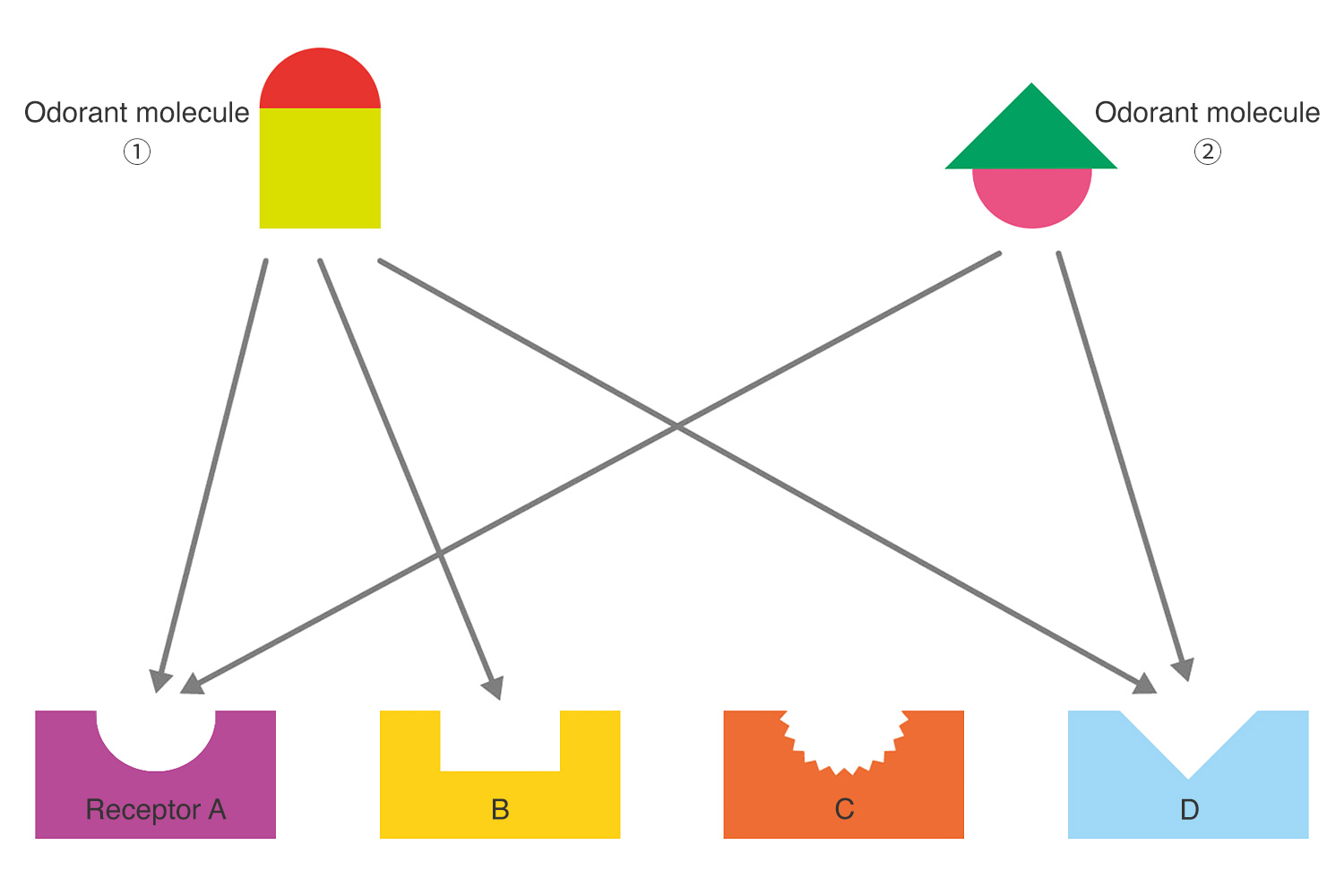
Sometimes, the wonderful smell of fermented soybean paste stew summons up the memory of my hometown where the sunset glow spread out over the evening sky, and of my mother who used to cook me dinner in the blink of an eye with her coarse hands. Like this, everyone probably has experienced that a piece of memory suddenly came up due to a certain familiar scent. Moreover, the memories are quite detailed and even bring back the emotions contained in them. Smell acts as an intense medium of memory. What secret is hidden in the sense of smell?
How we smell
A delicious smell that stimulates the tip of the nose makes the mouth water. The reality of various smells from food is actually a trace of chemical substances in the air. When molecules of food come into contact with the mucous membranes of the nose, olfactory receptors detect chemicals and send information to the brain, then the brain determines the identity of the smell through the information. All of this happens in an instant.
In mammals, there are about 1,000 types of genes responsible for smell, of which about 350 are actually manifested in humans. In the olfactory epithelium with a total area of the size of your thumbnail, about 350 kinds of olfactory receptor proteins are gathered together, waiting for the odorant molecules that are just right for them. The part where an olfactory receptor binds to an odorant molecule is different in shape. Olfactory receptors activate only with certain odorants that fit in the shape, just as a key can only unlock a lock that it fits in.
When odorant molecules bind with olfactory receptors, they produce electrical signals. These signals go up through olfactory nerves to the brain. Then, the cerebral cortex analyzes the combinations of olfactory signals to determine what kind of smell it is. That’s when the identity of the smell is finally revealed.
However, each olfactory receptor does not detect a single odor. Several receptors react simultaneously to one odorant molecule to distinguish different smells. Different receptors that bind with different parts of the molecule deliver different fragmentary information to the brain. It means it can be recognized as a myriad of different smells, depending on the combination of receptors that bind with the odorous substance. As a result, living things can smell more diverse smells than the types of olfactory receptors.

Recently, olfactory receptors have been found not only in the mucosa but also in the body. Olfactory receptors distributed in the kidneys are aware of the smell of intestinal microorganisms to regulate hormone secretion, and also help regenerate muscles. All these new facts are being discovered one by one.
Correlation between the sense of smell and memory
In the French writer Marcel Proust’s novel In Search of Lost Time, the leading character Marcel reminisces a nostalgic incident of his childhood, being inspired by the scent of a madeleine cake dipped in tea. Memories inspired by a scent make you feel like you are looking at an album of photos of those moments. Like this, a recollection of a memory after exposure to a scent is called the “Proust phenomenon.”
This happens because the sense of smell is transmitted directly to the cerebrum whereas the other sensory information moves to the cerebrum through the thalamus. Since the olfactory nerve is directly connected to the cerebral limbic system which is responsible for emotion and memory, it directly affects a person’s emotion and memory.

The information detected by olfactory receptors is sent to various places in the cerebral cortex. In the amygdala which is involved in emotional response, emotional information about smell is added and assessment for likes or dislikes is made; and in the hippocampus which governs long-term memory, the memories of smell are combined. Because the sense of smell is directly connected to the cerebrum, if one cannot distinguish different smells all of a sudden, the doctor may suspect early stages of neurological diseases such as Alzheimer’s.
Colors can be seen as they are such as red or yellow, and sound can be quantified by frequency or decibel. Unlike the other senses, there are few words that can generalize smell itself and describe it. That is why scent or smell is described through an object or memory from which the smell is derived. It is because the sense of smell is extremely subjective from person to person as it is intertwined with memory and emotions. Therefore, even for the same smell, there is clear distinction of likes and dislikes, depending on the person. The same smell can be pleasant to some people, but it can be unpleasant to others.
Companies sometimes apply this characteristic of smell to marketing. They stimulate consumers’ desire to purchase by using smell that inspires specific memories or fragrance that represents the image of the brand. It is like bakeries deliberately give off the smell of freshly baked bread in the morning. In Japan, a soap company even put an advertisement with ink mixed with the distinct scent of its product on the newspaper. It is because there is no sense that directly affects memory and emotion as much as the sense of smell does.
Sensitive sense of smell
When people are asked to choose a sense that they wouldn’t mind losing, most of them choose the sense of smell. This shows people are not much dependent on the sense of smell and do not regard it as important, either. Most animals rely on their sense of smell for much of their external information, so it is hard for them to survive in the ecosystem without the sense of smell. However, even if a human becomes anosmic and cannot distinguish smells at all, there is no big problem in living.
Nevertheless, the sense of smell is still important for humans. If you cannot smell, you will be unable to tell if food has gone bad. It is asserted that about 90 % of what we commonly think of as taste actually comes from the sense of smell. Since there are only four tastes that can be felt by the tongue, nearly all the diverse tastes that we feel depend on the sense of smell. This explains why we cannot really taste the food when we catch a cold and have a congested nose.
Dogs and pigs have various types of olfactory receptors, and the number of their olfactory cells is dozens of times more than those of humans, which allows them to smell even the things people cannot smell. Also, within the same species, the degree of olfactory ability varies greatly. Some people are sensitive and quick to notice even if there is just a little bit of smell, while others are dull and do not respond to even strong smells at all.

Compared with animals, humans’ olfactory ability is weak, but still surprisingly good. It is assumed that humans can identify up to 10,000 different smells by using some five million olfactory cells that have olfactory receptors. Some people’s sense of smell is sensitive enough to detect even if just one single molecule is mixed in about 2.5 million other molecules.
We easily distinguish the scents that we know clearly, such as banana or coffee, but we cannot distinguish the scents of unknown objects that we have not smelled before. However, if one is informed the list of the substances in advance, the probability of guessing the type of scent correctly increases. The reason it is difficult for us to pinpoint the identity of an unfamiliar smell is not because we cannot smell it, but because olfactory information is linked to many senses and because our ability to find the information of the smell in our memories is immature; an additional reason is that the sense of smell gets tired easily.
One of the scents that everyone is familiar with is the scent of a rose. Most ingredients of rose scent have been identified. However, even if hundreds of ingredients are mixed at actual proportions according to research data, the natural rose scent cannot be produced. The data analyzed by machine cannot distinguish between artificial scent and natural scent, but the nose of an experienced person such as a perfumer can pick out the delicate natural rose fragrance right away. That is why many companies still try to put even a little bit of natural rose oil in their products despite their high price.
What if all the smells disappear from the world? Our lives will be dry. We will be unable to smell fragrant flowers, and unable to taste food, either. When we close our eyes and smell the fresh green leaves, we come to reminisce about the good old days and feel refreshed. The sense of smell is electrical signals felt by the brain. But how can this simple description of the sense of smell explain its wonder fully?